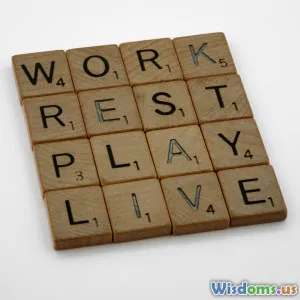
Freelance vs FullTime Which Path Leads to Better WorkLife Balance
7 min read Explore whether freelance or full-time work offers a better work-life balance through data, expert insights, and real-world examples. (0 Reviews)
Freelance vs Full-Time: Which Path Leads to Better Work-Life Balance?
Introduction
In the modern workforce, the pursuit of work-life balance has become a defining priority for many professionals. Whether it's the allure of flexible hours or the stability of a steady paycheck, one pivotal question lingers: does freelancing or full-time employment offer better work-life balance? At first glance, freelancing seems the clear winner with its promise of autonomy. Yet, full-time roles bring structured environments and predictable benefits. This article dives deep into these options, leveraging data, expert opinions, and real-life cases to help you decide which pathway creates a healthier balance between your career and personal life.
Understanding Work-Life Balance
Work-life balance is not just about the number of hours worked; it involves the quality and distribution of your energy, time, and attention between professional and personal spheres. The challenges vary across industries and roles, but fundamentally, an ideal work-life balance enables sustained productivity without burnout and enriches overall well-being.
Freelance Work: Flexibility at a Cost
The Appeal of Remote Independence
Freelancing offers unparalleled flexibility. According to the 2023 Upwork Workforce Report, 58% of freelancers consider schedule freedom their top benefit. This flexibility lets individuals design workdays around personal commitments—whether schooling children, traveling, or pursuing hobbies.
Self-Management and Its Challenges
However, the autonomy in freelancing isn't without pitfalls. Freelancers often juggle multiple roles: marketer, accountant, and executor. This can blur boundaries, extending work hours into evenings and weekends. A 2022 report by the Freelancers Union revealed that 40% of freelancers work over 50 hours weekly, leading to stress and irregular income flows.
Real-World Example: Sarah’s Story
Sarah, a graphic designer working freelance, enjoys working at her own pace but admits, "I sometimes find it hard to switch off because clients contact me at odd hours, and the uncertainty means I’m always hustling."
Financial Instability and Its Mental Toll
Unlike full-time workers, freelancers face unpredictable income without paid leave or health benefits. This financial uncertainty can undermine work-life balance. Building a buffer fund and streamlined invoicing systems are strategies successful freelancers use to mitigate stress.
Full-Time Employment: Stability Amid Structure
Predictability and Benefits
Full-time jobs often guarantee a regular paycheck, healthcare, paid time off, and retirement plans, fostering a sense of security. According to the Pew Research Center, 68% of full-time employees say these benefits play a crucial role in reducing work-life stress.
Work Hours and Rigid Boundaries
Contrary to popular belief, full-time roles with strict 9-to-5 hours can sometimes foster better separation between work and life. However, in some industries, mandatory overtime and workload pressures erode this boundary, affecting work-life equilibrium.
Company Policies Driving Balance
Many organizations are adapting to employee needs by instituting flex-time, remote work options, and mental health days. For instance, Google offers flexible hours coupled with on-site wellness centers, helping employees decompress and increase productivity.
Case in Point: Michael’s Experience
Michael, an accountant in a large firm, values his routine and benefits but notes, "The high workload during tax season sometimes makes it hard to maintain personal time. But generally, the company respects my 9-to-5 schedule."
Comparative Analysis: What Does The Data Say?
Surveys like Deloitte's 2022 Global Human Capital Trends show 77% of full-time employees report satisfaction with their work-life balance, compared to 65% of freelancers. However, freelancers often report higher job satisfaction due to autonomy. This suggests a trade-off: freelancers value freedom; full-timers value stability.
Factors Influencing Work-Life Balance Beyond Employment Type
Personal Discipline and Boundaries
A freelance lifestyle demands rigorous self-discipline to avoid burnout and ensure regular downtime. Full-time employees might benefit from organizational policies but need to actively manage encroachment of work on personal time.
Nature of the Work
Creative roles may thrive in freelance settings, while roles requiring teamwork and synchronized schedules might favor full-time employment.
Life Stage and Obligations
For new parents or caregivers, full-time roles with parental leave and consistent hours may offer better balance. Alternatively, those seeking travel or side projects might benefit more from freelancing.
Tips for Achieving Work-Life Balance Regardless of Path
- Set Clear Boundaries: Define specific work hours and unplug afterward.
- Prioritize Tasks: Use time management techniques like the Pomodoro method to boost productivity.
- Invest in Health: Regular exercise, sleep, and mental wellness practices help manage stress.
- Seek Support: Join peer groups or professional communities for shared learning and emotional support.
Conclusion
Neither freelance nor full-time work universally guarantees better work-life balance. Freelance careers excel in flexibility and autonomy but often come with income volatility and blurred boundaries. Full-time roles provide financial security and structure yet sometimes sacrifice personal flexibility.
Deciding which path leads to better work-life balance hinges on individual preferences, career goals, and life circumstances. Understanding trade-offs and conscientious boundary-setting can empower anyone to craft a career that supports both professional fulfillment and a rich personal life.
Ultimately, the balance you seek is within your control—whether you're your own boss or part of a bigger team.
References
- Upwork, 2023 Workforce Report
- Freelancers Union, 2022 Survey Data
- Pew Research Center, Benefits and Stress Study, 2023
- Deloitte, Global Human Capital Trends, 2022
Real names and scenarios have been used for illustration while respecting privacy
Rate the Post
User Reviews
Popular Posts



















